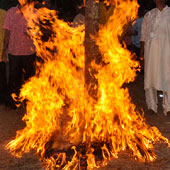Holi - from its mythological past to its present. The festival of Holi actually starts the night before with a bonfire made up of all the dried leaves and branches left through the winter. It is a way of clearing these and making way for spring. Metaphorically though, the fire is meant to signify the destruction of evil - the burning of the ‘Holika’ - a mythological character. The heat from the fire is also a reminder that winter is behind and that the hot summer days are ahead.
The following morning begins with worshipping Krishna by lovingly smearing his idol with ‘gulal’ - the colours used to play Holi. This is a festival that is as much a gateway to celebrate the arrival of spring as much as it is a way to celebrate the season of love. Krishna is the ultimate lover with his ‘gopikas’, who are a bunch of beautiful women that Krishna forever seems to be chasing. And yet this icon of love spends most of his time seeking out his only lover Radha. So Krishna’s love is the epitome of the freshness of youth amidst all its playfulness. Without Krishna and his lover Radha there can be no Holi.
Krishna’s mythological presence in Holi is undisputed. It is said that the festival is also a celebration of the death of Pootna - the demon who nearly killed Lord Krishna. The effigy of Pootna burnt the night before, therefore, ends up signifying death itself just as Pootna typifies winter and darkness.
There are more stories. This is the one about Holika who believed herself to be immuned to death by fire. And yet when she questions her nephew Prahlad’s devotion to the ultimate of Gods, Vishnu and threatens to walk through fire with the intention to destroy the prince, she is herself consumed by the fire whereas the prince comes out unscathed. This is the Holika that is burnt the night before Holi as the triumph of the good over evil.
This is where the celebration with colours comes in. Holi is supposed to be an exuberant show of goodwill and cheer. The riot of colours follows a revelry of colour play - quite unmatched in its boisterousness - and takes place amidst the sprinkling or the shower of coloured powder. And when this is combined with water it is anything but a damp squib. Everybody is welcome and everybody is pardoned for his or her revelry.
What do we do on the day of Holi
Smearing colors on friends and dear ones is the basic idea of Holi, no one is spared. Both the young and the old enjoy throwing water balloons, dry colors, and washable dyes on anyone in sight on the day of the holi. We go around in streets, with a tin drums, armed with tonnes of colors and big syringes filled with colored water. And at the end of the day no one will even remotely resemble themselves. To join us in our celebration you can particapate in many ways by joining us through virtual holi.

